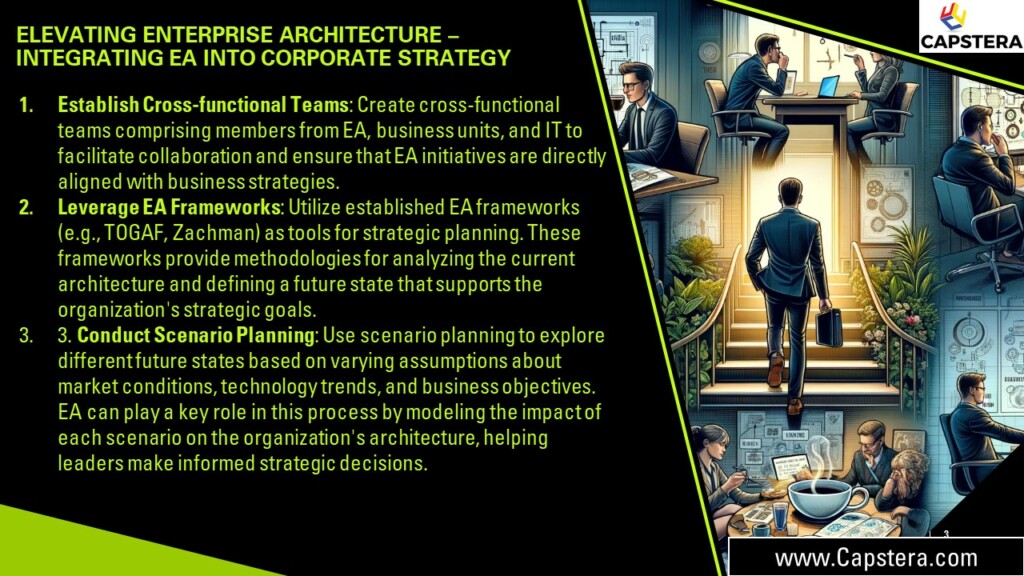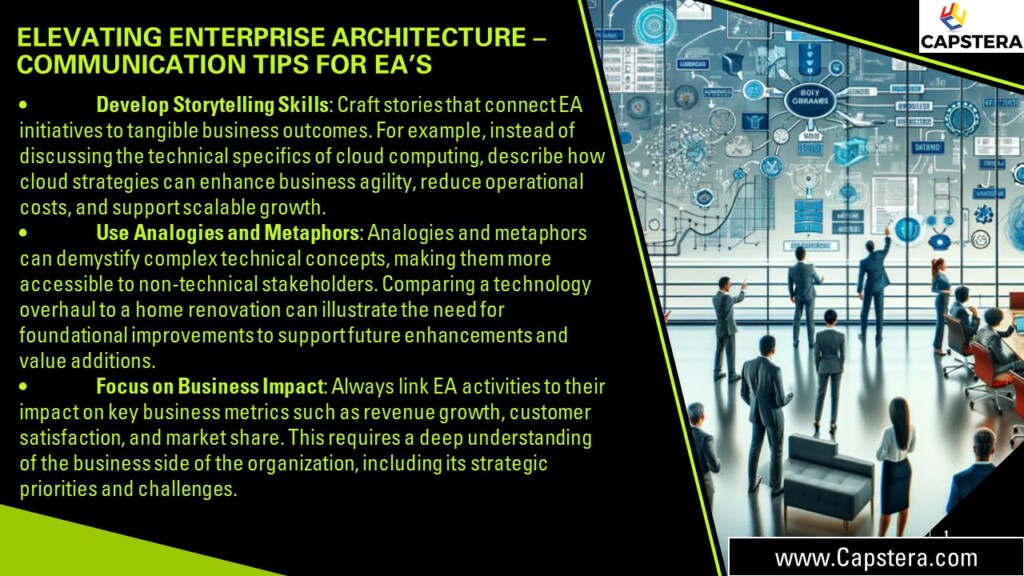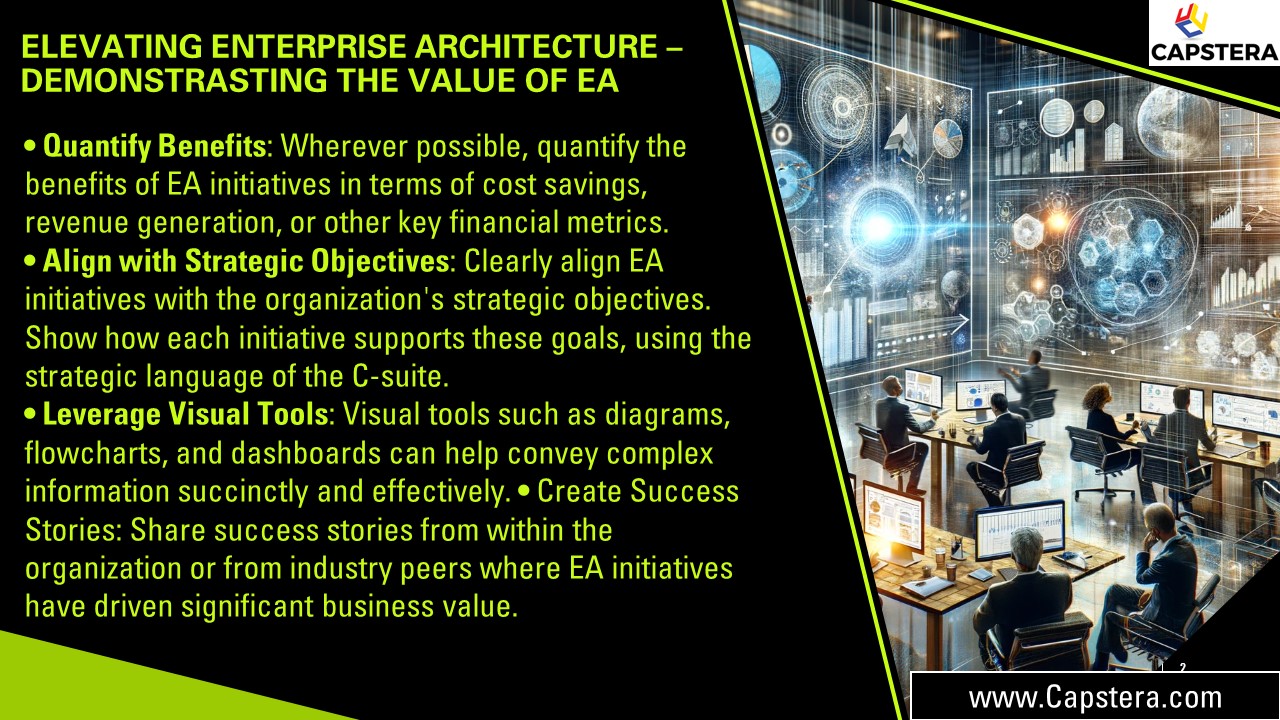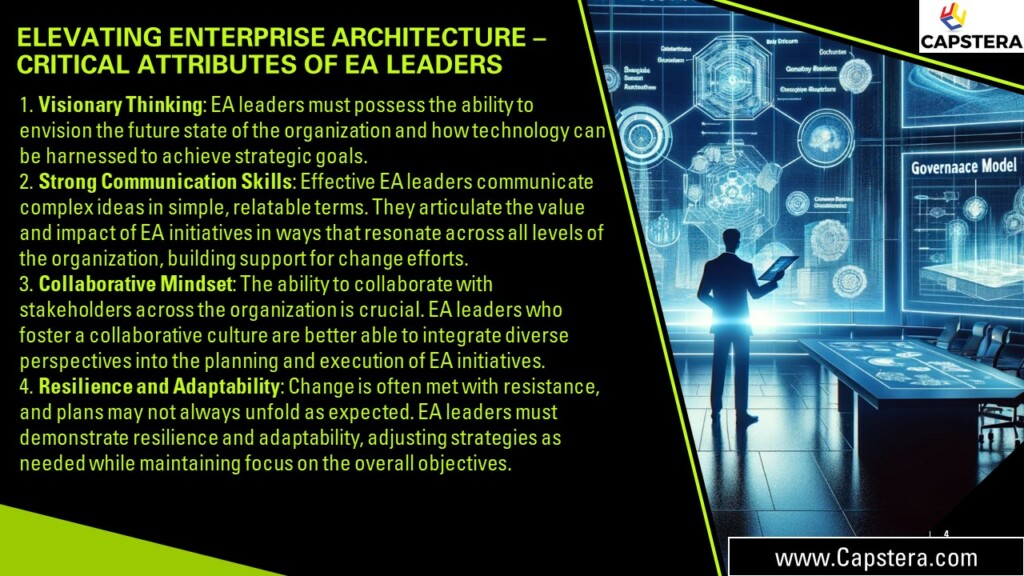
The Ultimate Guide to Elevating Enterprise Architecture to a Strategic Partner.
Definition and Evolution of Enterprise Architecture
Enterprise Architecture (EA) is a conceptual blueprint that defines an organization’s structure and operation. Its purpose is determining how an organization can most effectively achieve its current and future objectives. Originating in the late 20th century, the discipline of EA has evolved from its initial focus on IT infrastructure to encompass a broader vision that includes business processes, information systems, technologies, and the interrelationships between them. This evolution reflects the increasing recognition of information technology as a driver of business innovation and competitive advantage.
EA bridges an organization’s strategic vision and its practical implementation, ensuring that all aspects of its operations are aligned with its strategic goals. It provides a comprehensive framework that guides the development and management of IT systems with an eye toward future needs and capabilities.
Common Misconceptions about EA’s Role and Value
One of the most pervasive misconceptions about EA is that it is solely an IT concern, focusing on the technical aspects of an organization’s infrastructure. This view diminishes EA’s strategic value, relegating it to the role of overseeing software, hardware, and network systems. Consequently, EA efforts are often siloed within IT departments and disconnected from broader business strategy discussions.
Another common misconception is that EA is exclusively about creating rigid structures and processes. Critics argue that this can stifle innovation and agility, making organizations less responsive to market changes. However, when properly implemented, EA provides a flexible framework that enables organizations to adapt to change more efficiently, not less.
The value of EA is also frequently underestimated. It is seen as a cost center rather than a strategic investment that can drive long-term savings, efficiency, and competitive advantage. This perception can lead to underfunding and underutilization of EA initiatives, limiting their potential impact on the organization.
The Strategic Potential of EA in Driving Business Transformation
The true strategic potential of EA lies in its ability to align IT strategy with business strategy, ensuring that technology investments are directly tied to achieving business objectives. By providing a holistic view of an organization’s architecture, EA enables leaders to make informed decisions about where to invest in technology, how to streamline processes, and how to innovate effectively.
EA facilitates business transformation by identifying opportunities for optimization and innovation within the organization’s operations. It can uncover inefficiencies in current processes and systems, propose solutions that leverage new technologies, and map out a path for implementing these changes without disrupting business operations. This can lead to significant cost savings, improved operational efficiency, and enhanced customer satisfaction.
Moreover, EA plays a critical role in digital transformation initiatives, which are increasingly essential for organizations to remain competitive in today’s fast-paced, technology-driven market. EA helps organizations navigate the complex landscape of digital technologies, from cloud computing and big data to artificial intelligence and the Internet of Things. It ensures that digital transformation efforts are strategically aligned with business goals, maximizes the value of technology investments, and minimizes risks.
In essence, EA transcends its technical roots to become an organizational strategic enabler. It acts as a catalyst for innovation, a roadmap for transformation, and a guardrail for technology investments. When embraced by the C-suite and integrated into the fabric of business strategy, EA has the potential to drive significant and sustained competitive advantage.
Organizations must shift their perception of EA from a technical necessity to a strategic asset to realize this potential. This requires a change in mindset at the highest levels of leadership and a commitment to fostering closer collaboration between IT and business units. By overcoming the common misconceptions about EA and fully leveraging its strategic value, organizations can position themselves for success in an increasingly complex and technology-dependent world.
The Ultimate Guide to Elevating Enterprise Architecture to a Strategic Partner
Understanding the Gap: EA and C-Suite Perceptions
Exploring the Differences in Perspectives
The chasm between Enterprise Architecture (EA) practitioners and the C-suite stems from fundamentally different perspectives on the role of technology in business strategy. EA professionals often focus on architectural integrity, technology standards, and long-term IT strategy, emphasizing the importance of a cohesive and scalable IT environment. They see technology as an enabler of business capabilities, a viewpoint that necessitates a detailed understanding of technical specifics and architectural frameworks.
In contrast, C-suite executives prioritize business outcomes such as revenue growth, market expansion, cost reduction, and shareholder value. Their strategic focus is on leveraging technology for competitive advantage but through a lens of financial performance and business metrics. This focus drives a preference for investments with clear, short-term ROI over those perceived as long-term, foundational IT infrastructure projects.
The Impact of These Differences on EA’s Strategic Involvement
This divergence in focus can lead to EA’s reduced strategic involvement, as its activities may be viewed as too technical, slow-moving, or disconnected from immediate business priorities. Without a clear linkage between EA initiatives and measurable business outcomes, EA risks being sidelined in strategic discussions, and its potential contributions to business transformation and competitive advantage are overlooked.
The perception of EA as a cost center rather than a strategic asset exacerbates this situation. When the C-suite evaluates initiatives primarily through the lens of cost and short-term return, long-term, strategic IT investments advocated by EA can be difficult to justify, especially if their benefits are not immediately apparent or quantifiable in business terms. This dynamic can lead to underinvestment in EA, limiting its effectiveness and reinforcing misconceptions about its value.
Examples Illustrating the Consequences of Misalignment
Case Study 1: A Retail Giant’s Missed Digital Transformation Opportunity
A leading retail chain recognized the need for digital transformation to address declining in-store sales and growing online competition. The EA team proposed a comprehensive digital platform that integrated online and offline customer experiences, leveraging advanced analytics for personalized marketing and inventory optimization. However, the C-suite, focused on short-term cost-saving measures, opted for incremental IT upgrades and outsourced online operations.
Over time, the lack of a cohesive digital strategy led to disjointed customer experiences, inefficient operations, and lost market share. The company’s delayed response to digital trends, despite the EA team’s early warnings, resulted in significant financial losses and a costly, reactive transformation effort years later.
Case Study 2: Financial Services Firm Avoids Disruption Through Strategic EA Integration
In contrast, a global financial services firm faced potential disruption from fintech startups offering innovative, customer-friendly solutions. The firm’s EA team, working closely with the C-suite, developed a strategy to leverage cloud computing and blockchain technology, aiming to enhance customer service and reduce transaction costs.
By framing their recommendations in terms of business outcomes—specifically, customer satisfaction scores, transaction speed, and operational costs—the EA team secured executive buy-in for a multi-year transformation program. The initiative not only defended against competitive threats but also positioned the firm as a market leader in customer-centric innovation. This success story highlights the potential of aligning EA initiatives with C-suite priorities, focusing on tangible business outcomes.
The gap in perspectives between EA practitioners and the C-suite presents significant challenges to leveraging technology strategically. However, it also offers an opportunity for EA to redefine its role and value proposition. By aligning their efforts more closely with business objectives and speaking the language of the C-suite, EA practitioners can bridge this gap, ensuring that technology investments are both strategic and transformative. The contrasting outcomes in the case studies underscore the importance of this alignment for achieving competitive advantage and avoiding the pitfalls of misalignment and missed opportunities.
Bridging the Language Barrier between EA and the C-Suite
The Crucial Role of Communication in Alignment
Effective communication is the linchpin in aligning IT and business goals, serving as the bridge over the chasm that often separates Enterprise Architecture (EA) practitioners from the C-suite. The ability to articulate the value of EA in terms that resonate with business leaders is essential for securing their support and investment. This requires moving beyond the technical jargon of EA and IT to speak the language of business impact, ROI, and competitive advantage.
Communication gaps can lead to missed opportunities, where valuable EA initiatives are overlooked or underfunded due to a perceived lack of relevance to business objectives. Conversely, clear and compelling communication can illuminate how EA strategies enable business goals, fostering a shared understanding and commitment to a unified strategy.
Strategies for Translating Technical Jargon into Business-Relevant Narratives
One effective strategy for bridging the communication gap is to frame EA initiatives within the context of business challenges and opportunities. This involves translating technical aspects of EA work into narratives that highlight how technology solutions address specific business needs, contribute to strategic goals, and offer competitive advantages.
- Develop Storytelling Skills: Craft stories that connect EA initiatives to tangible business outcomes. For example, instead of discussing the technical specifics of cloud computing, describe how cloud strategies can enhance business agility, reduce operational costs, and support scalable growth.
- Use Analogies and Metaphors: Analogies and metaphors can demystify complex technical concepts, making them more accessible to non-technical stakeholders. Comparing a technology overhaul to a home renovation can illustrate the need for foundational improvements to support future enhancements and value additions.
- Focus on Business Impact: Always link EA activities to their impact on key business metrics such as revenue growth, customer satisfaction, and market share. This requires a deep understanding of the business side of the organization, including its strategic priorities and challenges.
Techniques for Demonstrating the Business Value of EA Initiatives
Demonstrating the business value of EA initiatives is critical for gaining executive buy-in and ensuring their strategic involvement. The following techniques can help EA leaders articulate this value effectively:
- Quantify Benefits: Wherever possible, quantify the benefits of EA initiatives in terms of cost savings, revenue generation, or other key financial metrics. Use data and analytics to support your claims, providing a solid foundation for your arguments.
- Align with Strategic Objectives: Clearly align EA initiatives with the organization’s strategic objectives. Show how each initiative supports these goals, using the strategic language of the C-suite. This alignment underscores the relevance and strategic importance of EA activities.
- Leverage Visual Tools: Visual tools such as diagrams, flowcharts, and dashboards can help convey complex information succinctly and effectively. They can illustrate how disparate parts of the organization are interconnected and how changes in the EA can impact overall business performance.
- Create Success Stories: Share success stories from within the organization or from industry peers where EA initiatives have driven significant business value. These stories can serve as powerful testimonials to the strategic potential of EA.
Bridging the language barrier between EA and the C-suite is a vital step towards aligning IT and business goals. By adopting strategies that translate technical jargon into business-relevant narratives and demonstrating the concrete business value of EA initiatives, EA leaders can secure the support and engagement of senior executives. This alignment is crucial for leveraging technology strategically to drive business transformation and achieve competitive advantage. Clear, compelling communication not only elevates the status of EA within the organization but also ensures that its potential as a strategic enabler is fully realized.
Aligning Metrics: From Technical KPIs to Business Outcomes
Overview of Common EA Metrics Versus Those Valued by the C-Suite
Enterprise Architecture (EA) metrics often focus on technical performance, architecture compliance, system interoperability, and IT cost efficiency. These metrics are crucial for ensuring that the IT infrastructure is robust, scalable, and cost-effective. Examples include system downtime, response time, compliance rates with architecture standards, and IT spending as a percentage of revenue.
In contrast, the C-suite prioritizes metrics that directly impact the bottom line and strategic goals of the organization. These include revenue growth, market share, customer satisfaction and retention, operational costs, and return on investment (ROI). While both sets of metrics are important, the challenge lies in demonstrating how EA metrics influence those valued by the C-suite, thus proving the strategic value of EA initiatives.
Methods for Linking EA Metrics with Business Performance Indicators
To bridge the gap between EA and business metrics, EA leaders must develop methods to link technical KPIs to broader business performance indicators. This connection helps articulate the value of EA in terms that resonate with the C-suite. Here are several methods to achieve this linkage:
- Map Technical Metrics to Business Objectives: Start by mapping specific technical metrics to business objectives. For example, show how reducing system downtime (a technical metric) can enhance customer satisfaction and retention (business metrics), leading to increased revenue.
- Adopt Business Value Dashboards: Implement dashboards that translate technical KPIs into business impacts. These dashboards can visually demonstrate how improvements in IT infrastructure contribute to business goals like reducing operational costs or increasing market responsiveness.
- Use Predictive Analytics: Employ predictive analytics to forecast the business impact of potential EA decisions. This approach can help in making a compelling case for investments in EA by showing their expected contribution to business outcomes.
Frameworks for Measuring and Communicating the Impact of EA on Business Outcomes
Developing a comprehensive framework for measuring and communicating the impact of EA on business outcomes involves several key components:
- Balanced Scorecard Approach: Adapt the balanced scorecard approach to include both EA and business metrics, ensuring a holistic view of performance across different dimensions (financial, customer, internal processes, and learning and growth). This approach facilitates alignment between IT and business strategies by linking EA initiatives to business outcomes.
- Value Realization Framework: Implement a value realization framework that tracks the journey from EA activities to business impacts. This framework should outline the expected outcomes of EA initiatives, measures of success, and the actual benefits realized. It should also include both qualitative and quantitative data to provide a complete picture of EA’s contribution to business goals.
- Communication Strategy: Develop a targeted communication strategy to regularly share the outcomes and benefits of EA initiatives with the C-suite and other stakeholders. This could involve quarterly reports, presentations, or interactive workshops. The key is to tailor the communication to the audience, focusing on the strategic implications of the EA metrics rather than the technical details.
Aligning EA metrics with those valued by the C-suite is crucial for demonstrating the strategic value of EA initiatives. By mapping technical KPIs to business objectives, adopting business value dashboards, and using predictive analytics, EA leaders can more effectively communicate the impact of EA on business outcomes. Implementing frameworks like the balanced scorecard and value realization framework further supports this alignment, ensuring a comprehensive approach to measuring and communicating EA’s contribution to the organization’s strategic goals. Through these efforts, EA can be recognized not just as a technical discipline but as a vital contributor to business success.
Rebranding EA from Cost Center to Value Creator
The transformation of Enterprise Architecture (EA) from being perceived as a mere cost center to a strategic investment is pivotal for its integration into the core strategic planning and decision-making processes of an organization. Let’s explore strategies to shift this perception, underscore the importance of effective financial modeling and ROI demonstration in EA projects, and delve into best practices for budgeting and financial communication within EA initiatives.
Strategies for Shifting Perception
- Articulate EA’s Role in Achieving Strategic Business Objectives: Begin by clearly defining and communicating how EA directly supports the organization’s strategic objectives. This involves translating technical capabilities into business benefits, such as improved market agility, enhanced customer experience, or increased operational efficiency.
- Showcase EA as an Innovation Driver: Position EA as a key player in identifying and implementing innovative technologies that can open new revenue streams or enhance competitive advantage. Highlighting EA’s role in digital transformation, for instance, can illustrate its potential as a catalyst for growth and innovation.
- Demonstrate Cost Savings and Efficiency Gains: Proactively identify and communicate the cost savings and efficiency gains achieved through EA initiatives. This can include reductions in IT costs due to rationalization of applications, improvements in process efficiencies, or avoidance of costly technology missteps.
- Foster a Culture of Continuous Improvement: Encourage the perception of EA as a dynamic process that continuously seeks to align IT infrastructure and services with business goals, thus driving ongoing value creation.
Case Studies on Effective Financial Modeling and ROI Demonstration
Case Study 1: Global Retailer’s Cloud Transformation Initiative
A global retailer embarked on a cloud transformation initiative, guided by its EA team, to enhance scalability and reduce IT operational costs. The EA team conducted a comprehensive financial analysis to project the cost savings from reduced data center operations and increased operational efficiency. By comparing the current state costs with the projected costs post-implementation, they demonstrated a significant ROI. The project was communicated as a strategic investment that not only reduced costs but also increased the company’s agility in responding to market demands. The initiative was a success, resulting in a 30% reduction in IT operational costs and a substantial improvement in e-commerce platform performance.
Case Study 2: Financial Services Firm’s Application Rationalization
A financial services firm faced significant IT costs due to redundant and legacy applications. The EA team initiated an application rationalization project, aiming to consolidate applications and retire obsolete ones. Through careful financial modeling, the team projected a 20% reduction in application maintenance costs and a 15% improvement in operational efficiency. By highlighting the direct impact on the bottom line, the project was recognized as a strategic initiative that not only saved costs but also enhanced operational agility. The successful implementation led to reduced IT expenditure and improved service quality.
Best Practices for Budgeting and Financial Communication
- Align Budget Requests with Strategic Priorities: Ensure that budget requests for EA initiatives are directly linked to the organization’s strategic priorities. This alignment demonstrates the strategic value of EA investments and facilitates their approval.
- Develop Detailed Financial Models: Utilize detailed financial models to project the costs, savings, and ROI of EA initiatives. These models should include all relevant financial metrics, such as cash flow impact, net present value (NPV), and payback period, to provide a comprehensive view of the financial implications.
- Communicate Financial Benefits Clearly and Concisely: When communicating with the C-suite and other stakeholders, focus on the key financial benefits of EA initiatives. Use clear and concise language, avoiding technical jargon, to make the financial implications easily understandable.
- Leverage Visuals in Financial Presentations: Use charts, graphs, and dashboards in financial presentations to visually convey the financial benefits of EA initiatives. Visual representations can make complex financial data more accessible and compelling.
Shifting the perception of EA from a cost center to a value creator requires a strategic approach to defining its role, demonstrating its financial benefits, and communicating its value effectively. By employing the strategies discussed and learning from successful case studies, EA leaders can reposition EA as a critical strategic investment that drives innovation, efficiency, and competitive advantage. Adopting best practices for budgeting and financial communication further ensures that the value of EA is clearly understood and appreciated across the organization.
Strategic Planning and Execution through Enterprise Architecture
The integration of Enterprise Architecture (EA) into strategic planning and execution marks a pivotal evolution in how organizations leverage technology to achieve their business objectives. Let’s dive into the role of EA in this context, outline techniques for its integration into corporate strategy, and discuss methods to ensure agile and adaptive strategic planning through EA.
The Role of EA in Strategic Planning and Digital Transformation
EA’s role in strategic planning is to provide a structured framework that aligns IT infrastructure and services with the business’s strategic goals. Doing so ensures that technology investments are not only justified but are directly contributing to the organization’s overarching objectives. In the context of digital transformation, EA becomes even more critical. It serves as the blueprint for the organization’s digital journey, identifying the technologies, systems, and processes that need to be transformed or implemented to meet future business models and market demands.
EA helps organizations navigate the complexities of digital transformation by offering a holistic view of the current state of IT and its future state requirements. This comprehensive perspective enables decision-makers to identify key digital initiatives, assess their potential impact, and prioritize them according to strategic goals. Moreover, EA provides a governance model to manage the execution of these initiatives, ensuring they remain aligned with the strategic vision throughout their lifecycle.
Techniques for Integrating EA into Corporate Strategy Formulation and Execution

Elevating Enterprise Architecture to a Strategic Partner – Integrating into Corporate Strategy Process.
- Establish Cross-functional Teams: Create cross-functional teams comprising members from EA, business units, and IT to facilitate collaboration and ensure that EA initiatives are directly aligned with business strategies. These teams can work together on strategic planning, identifying where technology can drive business value, and setting priorities for implementation.
- Leverage EA Frameworks: Utilize established EA frameworks (e.g., TOGAF, Zachman) as tools for strategic planning. These frameworks provide methodologies for analyzing the current architecture and defining a future state that supports the organization’s strategic goals. They also offer guidelines for governance and implementation, ensuring that the execution of the strategy remains on track.
- Conduct Scenario Planning: Use scenario planning to explore different future states based on varying assumptions about market conditions, technology trends, and business objectives. EA can play a key role in this process by modeling the impact of each scenario on the organization’s architecture, helping leaders make informed strategic decisions.
Methods for Agile and Adaptive Strategic Planning via EA
- Adopt an Iterative Approach: Implement an iterative approach to strategic planning with EA, where the strategy is reviewed and adjusted regularly based on new insights, market conditions, and technological advancements. This agility ensures that the organization’s architecture remains aligned with its evolving strategic goals.
- Embrace Change Management Principles: Incorporate change management principles into the EA strategy to facilitate smooth transitions and ensure organizational buy-in. Effective communication, stakeholder engagement, and training are essential components of this approach, helping to overcome resistance and build a culture that embraces change.
- Implement Continuous Feedback Loops: Establish continuous feedback loops between EA teams and business units to ensure that the architecture remains responsive to business needs. This involves regular reviews of the architecture’s performance against strategic objectives and the incorporation of feedback to refine and adjust the strategy as needed.
- Utilize Agile EA Practices: Apply agile practices to EA to enhance its responsiveness and flexibility. This can include breaking down large initiatives into smaller, manageable projects with clear, short-term objectives and employing rapid prototyping to test and refine ideas before full-scale implementation.
Integrating EA into strategic planning and execution transforms it from a support function into a strategic partner capable of guiding the organization through digital transformation and beyond. By establishing cross-functional teams, leveraging EA frameworks, and adopting agile and adaptive planning methods, organizations can ensure that their technology strategies are fully aligned with their business objectives. This alignment is crucial for driving innovation, achieving competitive advantage, and realizing the full potential of digital transformation efforts. Through these practices, EA can significantly contribute to the strategic planning process, ensuring that technology investments are strategically sound, effectively executed, and capable of driving sustained business growth.
Fostering Innovation and Optimization through Enterprise Architecture
Enterprise Architecture (EA) is a pivotal element in fostering innovation and driving operational optimization within organizations. By providing a structured framework for the assessment and implementation of technology, EA plays a crucial role in identifying opportunities for innovation and enhancing operational efficiencies. Let’s explore EA’s role in innovation and optimization, outline strategies for leveraging EA in these endeavors, and present case studies highlighting successful outcomes.
EA’s Role in Identifying and Implementing Innovative Technologies and Processes
EA serves as the backbone for understanding the current technological landscape of an organization and envisioning future states that embrace innovation. It offers a holistic view of the organization’s processes, information systems, and technology infrastructure, enabling the identification of areas ripe for innovation. By aligning IT strategy with business goals, EA ensures that technological innovations are not just technologically sound but also strategically focused.
EA helps in the vetting and adoption of emerging technologies such as artificial intelligence (AI), blockchain, and the Internet of Things (IoT), ensuring they are integrated seamlessly with existing systems and processes. This strategic approach to innovation facilitates the creation of new business models, products, and services that can provide a competitive edge in the market.
Strategies for Using EA to Optimize Operational Efficiencies and Reduce Redundancies
- Conduct Comprehensive Architecture Assessments: Regularly review and assess the entire architecture to identify inefficiencies, redundancies, and areas where technology could streamline operations. This involves not just technology audits but also reviews of business processes and data flows.
- Prioritize Standardization and Integration: Use EA principles to standardize technology platforms and processes across the organization. This reduces complexity, lowers maintenance costs, and facilitates easier integration of new technologies.
- Leverage Data for Decision-Making: Develop a data architecture that supports the effective use and analysis of data across the organization. By making informed decisions based on accurate data, businesses can optimize operations and identify areas for innovation.
- Promote Agile Development Practices: Implement agile development practices within the EA framework to encourage rapid prototyping, iterative development, and continuous feedback. This approach allows for faster innovation cycles and the ability to adapt quickly to changing market demands.
Successful Innovation and Optimization Driven by EA
Case Study 1: Healthcare Provider Enhances Patient Care Through Digital Transformation
A large healthcare provider utilized EA to guide its digital transformation with the aim of enhancing patient care. By mapping out its current and desired future states, the organization identified key areas where technology could improve patient experiences and operational efficiency. The implementation of an integrated electronic health record (EHR) system facilitated seamless information flow between departments, reduced administrative burdens, and provided caregivers with real-time access to patient data. This transformation, rooted in EA planning, resulted in improved patient outcomes, higher satisfaction rates, and significant operational savings.
Case Study 2: Retail Giant Drives Efficiency with AI and Big Data
Facing stiff competition from online retailers, a traditional brick-and-mortar retail giant turned to EA to revitalize its business model. The EA team led an initiative to leverage AI and big data analytics to optimize inventory management and personalize customer experiences. By integrating these technologies into the existing architecture, the retailer was able to predict consumer trends more accurately, manage inventory more efficiently and offer tailored promotions, resulting in increased sales and reduced operational costs. The success of this initiative highlighted the power of EA in driving innovation and operational excellence.
Enterprise Architecture is instrumental in driving both innovation and optimization within organizations. Through its structured approach to technology and process integration, EA enables businesses to stay ahead of technological advancements and adapt to changing market conditions. By fostering a culture of continuous improvement and leveraging data for informed decision-making, organizations can harness the full potential of EA to achieve operational efficiencies and innovate for competitive advantage. The case studies underscore the transformative impact of EA when strategically applied to foster innovation and optimize operations, demonstrating its critical role in the sustained success of an organization.
Building Collaborative Relationships within the Organization
The success of Enterprise Architecture (EA) hinges not just on the robustness of its frameworks and strategies but equally on the strength of its collaborative relationships within the organization. Building strong partnerships with business and IT leaders, engaging stakeholders effectively, and fostering cross-functional teams are fundamental to integrating EA deeply into the strategic fabric of the organization. Let’s explore strategies for nurturing these relationships, underscore the importance of stakeholder engagement, and outline best practices for establishing collaborative governance models that incorporate EA perspectives.
Strategies for EA Leaders to Build Strong Partnerships
- Develop Business Acumen: EA leaders must understand the business side of operations as well as the technical side. Developing business acumen enables EA leaders to communicate the value of EA initiatives in terms that resonate with business leaders, thereby fostering mutual respect and collaboration.
- Establish Regular Communication Channels: Open and regular communication with business and IT leaders helps in aligning EA initiatives with business goals and IT capabilities. This could be through regular strategy meetings, workshops, or informal catch-ups, ensuring EA remains a central consideration in strategic decision-making.
- Champion Co-creation of Solutions: Involve business and IT leaders in the creation and development of EA solutions. This co-creation process ensures that solutions are realistic, tailored to the organization’s needs, and have buy-in from all relevant parties from the outset.
- Provide Continuous Education: Educate stakeholders about the benefits and processes of EA. Continuous education helps demystify EA and fosters a culture of understanding and support across the organization.
The Importance of Stakeholder Engagement and Cross-functional Teams
Engaging stakeholders throughout the EA process is critical for ensuring that initiatives are well-received and effectively implemented. Stakeholder engagement helps in identifying potential resistance early, allows for the incorporation of a wide range of insights into EA planning, and ensures that the benefits of EA initiatives are widely understood and supported.
Cross-functional teams, comprising members from different business units and IT, are vital for integrating diverse perspectives into EA initiatives. These teams facilitate a holistic approach to problem-solving, ensuring that EA solutions are comprehensive, innovative, and aligned with both business and IT objectives. Moreover, working in cross-functional teams helps in breaking down silos within the organization, fostering a culture of collaboration and shared responsibility.
Best Practices for Collaborative Governance Models
- Include Diverse Perspectives in Governance Structures: Ensure that EA governance structures include representatives from various parts of the organization, including business units, IT, finance, and operations. This diversity ensures that decisions are balanced and take into account the broader interests of the organization.
- Implement a Decentralized Decision-making Process: Adopt a decentralized approach to decision-making where possible, allowing teams closer to specific issues to make informed decisions. This approach enhances agility and ensures that decisions are made with the most relevant information.
- Establish Clear Roles and Responsibilities: Clearly define the roles, responsibilities, and authority of different stakeholders within the EA governance model. This clarity helps avoid conflicts, ensure smooth decision-making, and facilitate effective implementation of EA initiatives.
- Foster a Culture of Transparency and Accountability: Develop a culture where decisions, processes, and outcomes are transparent, and stakeholders are accountable for their contributions to EA initiatives. Transparency and accountability build trust and support across the organization, enhancing the effectiveness of governance models.
Building collaborative relationships within the organization is crucial for the success and integration of EA. By developing strong partnerships with business and IT leaders, engaging stakeholders effectively, and fostering cross-functional teams, EA leaders can ensure that EA initiatives are aligned with business goals and have the support necessary for their successful implementation. Implementing collaborative governance models that include diverse perspectives and emphasize transparency and accountability further solidifies the foundation for EA’s success. These strategies and best practices are instrumental in embedding EA into the organizational culture, making it a pivotal force for strategic planning and execution.
The role of Enterprise Architecture (EA) in leading and managing organizational change cannot be overstated. As organizations navigate the complexities of digital transformation and adapt to rapidly evolving market conditions, EA leaders emerge as pivotal change agents. Let’s explore the critical attributes of effective EA leaders, strategies for leading change through EA initiatives, and techniques for overcoming resistance and fostering organizational resilience.
Critical Attributes of Effective EA Leaders
- Visionary Thinking: EA leaders must possess the ability to envision the future state of the organization and how technology can be harnessed to achieve strategic goals. This forward-thinking approach helps in guiding the organization through the complexities of change and transformation.
- Strong Communication Skills: Effective EA leaders communicate complex ideas in simple, relatable terms. They articulate the value and impact of EA initiatives in ways that resonate across all levels of the organization, building support for change efforts.
- Collaborative Mindset: The ability to collaborate with stakeholders across the organization is crucial. EA leaders who foster a collaborative culture are better able to integrate diverse perspectives into the planning and execution of EA initiatives, enhancing their effectiveness and acceptance.
- Resilience and Adaptability: Change is often met with resistance, and plans may not always unfold as expected. EA leaders must demonstrate resilience and adaptability, adjusting strategies as needed while maintaining focus on the overall objectives.
Strategies for Leading and Managing Change through EA Initiatives
- Align EA Initiatives with Business Goals: Ensure that all EA initiatives are clearly aligned with the strategic goals of the organization. This alignment helps in securing executive support and underscores the strategic relevance of EA efforts.
- Engage Stakeholders Early and Often: Involve stakeholders from the outset of planning and throughout the execution of EA initiatives. Early and ongoing engagement helps identify concerns, build consensus, and ensure that the change is driven by a shared vision.
- Develop a Roadmap for Change: Create a detailed roadmap that outlines the steps needed to achieve the desired transformation. This roadmap should include milestones, key performance indicators (KPIs), and a timeline, providing a clear path forward and means to measure progress.
- Foster a Culture of Continuous Learning: Encourage a culture where experimentation, learning from failures, and continuous improvement are valued. This culture supports the iterative nature of change and innovation, making the organization more agile and responsive.
Techniques for Overcoming Resistance and Building Organizational Resilience
- Communicate the Why Behind Changes: Clearly articulate the reasons behind changes and the benefits they are expected to bring. Understanding the ‘why’ helps in mitigating resistance by addressing concerns and illustrating the positive outcomes of the transformation.
- Provide Training and Support: Equip employees with the skills and knowledge needed to navigate the changes. Training and support mechanisms should be put in place to ease the transition, reduce anxiety, and empower individuals to contribute to the transformation.
- Celebrate Short-term Wins: Recognize and celebrate short-term achievements along the path to transformation. Celebrating wins builds momentum, reinforces the value of the change efforts, and boosts morale.
- Build Feedback Loops: Implement mechanisms for ongoing feedback, allowing for the capture of insights, suggestions, and concerns from across the organization. Feedback loops facilitate continuous adaptation and improvement, making the organization more resilient to change.
EA leaders play a critical role as change agents in driving organizational transformation. By embodying key attributes such as visionary thinking, strong communication, collaboration, resilience, and adaptability, EA leaders can effectively guide their organizations through the complexities of change. Employing strategic approaches to align EA initiatives with business goals, engaging stakeholders, developing clear roadmaps, and fostering a culture of continuous learning is essential for successful transformation. Additionally, overcoming resistance and building organizational resilience is paramount, requiring clear communication, support mechanisms, recognition of achievements, and feedback loops. Through these strategies and techniques, EA leaders can lead their organizations toward a future state that is aligned with strategic objectives, technologically advanced, and resilient in the face of change.
Future Directions for Enterprise Architecture
As the digital landscape continues to evolve, so too does the field of Enterprise Architecture (EA). Emerging trends and technologies are reshaping what it means to be an EA professional, expanding the role to encompass not just the alignment of IT and business strategies but also the orchestration of digital transformation efforts across organizations. Let’s delve into the emerging trends influencing the future of EA, examine the evolving role of EA in the context of key technological advancements, and outline the skills, competencies, and mindsets required for the next generation of EA leaders.
Emerging Trends and Technologies Shaping the Future of EA
- Digital Ecosystems and Platforms: The rise of digital ecosystems and platforms is encouraging organizations to extend their operations beyond traditional boundaries. EA is pivotal in designing these platforms and ecosystems, ensuring they deliver value and foster seamless integration with partners, suppliers, and customers.
- Artificial Intelligence and Machine Learning: AI and ML are becoming integral to EA, offering unprecedented opportunities for automating processes, enhancing decision-making, and personalizing customer experiences. EA professionals must understand how to leverage these technologies to drive strategic advantages.
- Edge Computing: As data generation and processing needs continue to grow, edge computing is emerging as a vital trend. EA must adapt to incorporate edge computing architectures, enabling faster, more reliable data processing and analysis close to the source of data generation.
- Sustainability and Green IT: With an increasing focus on sustainability, EA is taking a leading role in developing green IT strategies. This involves optimizing energy use, reducing waste, and ensuring that IT operations contribute to the organization’s sustainability goals.
The Evolving Role of EA in Digital Transformation, AI, and Cloud Computing
The role of EA is expanding in response to the rapid adoption of digital technologies. In the context of digital transformation, EA professionals are not just architects of the IT landscape but also strategists and advisors guiding the organization through complex digital change. They play a critical role in identifying how digital technologies, such as AI and cloud computing, can be leveraged to innovate business models, streamline operations, and create new value propositions.
- Digital Transformation: EA leaders are instrumental in developing a cohesive digital transformation strategy that aligns technology investments with business goals, ensuring that digital initiatives drive competitive advantage and organizational agility.
- Artificial Intelligence: In the realm of AI, EA’s role involves integrating AI capabilities into existing business processes, identifying opportunities for AI-driven innovation, and establishing ethical AI use guidelines to mitigate risks and ensure responsible deployment.
- Cloud Computing: Cloud computing has shifted the IT landscape dramatically. EA professionals must navigate this shift, crafting cloud strategies that optimize cost, performance, and scalability while ensuring security and compliance.
Preparing for the Future: Skills, Competencies, and Mindsets
The future of EA demands a new set of skills, competencies, and mindsets:
- Strategic Thinking and Business Acumen: EA leaders must possess deep strategic thinking capabilities and business acumen to align technology solutions with business goals and market dynamics.
- Technical Proficiency with Emerging Technologies: A solid understanding of emerging technologies, their potential applications, and implications is essential for crafting future-ready architectures.
- Adaptability and Continuous Learning: The pace of technological change requires EA professionals to be highly adaptable and committed to continuous learning, staying abreast of the latest trends and innovations.
- Collaborative Leadership: The ability to lead through influence, fostering collaboration across business units and functional areas, is increasingly important in the interconnected digital enterprise.
- Ethical Consideration and Sustainability Focus: EA leaders must integrate ethical considerations into technology deployments, particularly with AI, and champion sustainability initiatives through green IT practices.
Enterprise Architecture’s future is exciting and challenging, characterized by rapid technological advancements and shifting organizational paradigms. As EA continues to evolve, professionals in the field must adapt to emerging trends, embrace the expanding scope of their role in digital transformation, and acquire the necessary skills and mindsets to lead their organizations into the future. By staying at the forefront of technological innovation, maintaining a strategic focus, and fostering a culture of continuous learning and ethical consideration, the next generation of EA leaders will be well-equipped to navigate the complexities of the digital age and drive meaningful, sustainable change.






